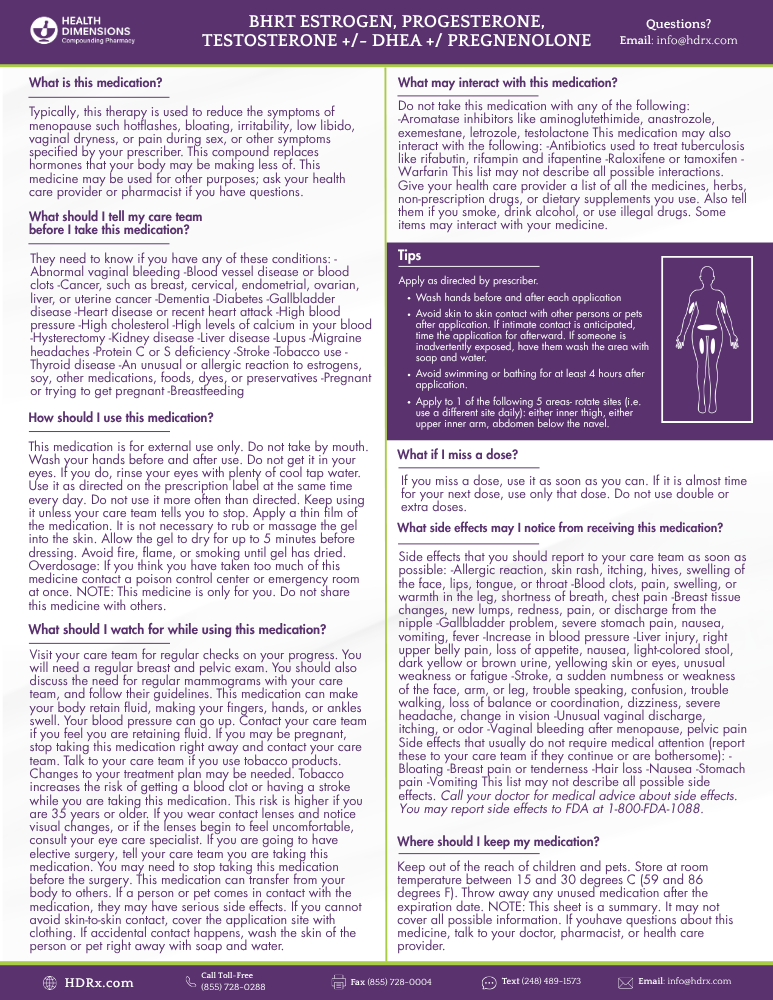Bioidentical Hormone Replacement Therapy (BHRT) is an area of growing interest for women and healthcare professionals seeking individualized approaches to hormone health.
This five-part blog series by Healing Dose Compounding Pharmacy explores key hormones commonly included in BHRT protocols. In Part 4, we focus on progesterone, a calming, balancing hormone that supports uterine health, sleep quality, mood stability, and overall hormonal harmony during and after menopause.
Read BHRT Series Part 1: Estradiol Cream, Troche, Capsules, and More
When most people think about hormone therapy for women in menopause, estrogen is usually the star of the conversation. Yet, for many women, progesterone is equally important. In bioidentical hormone replacement therapy (BHRT), progesterone isn’t just there to balance estrogen’s effects on the uterus; it plays a role in many important processes including sleep, mood, bone health, and much more.
What Progesterone Does in the Body
Progesterone is produced mainly by the ovaries during the luteal phase of the menstrual cycle and in smaller amounts by the adrenal glands and, during pregnancy, the placenta. Its primary reproductive role is to prepare and maintain the endometrium for implantation. However, its influence extends far beyond reproduction.
Menopause Symptoms That May Improve With Progesterone
Menopause affects every woman differently, but declining progesterone levels — often starting in perimenopause — can contribute to a range of symptoms that go beyond the well-known hot flashes. When used as part of bioidentical hormone replacement therapy (BHRT), progesterone may help address several of these concerns:
- Sleep Disturbances – Many women notice difficulty falling or staying asleep during menopause. Progesterone’s metabolite, allopregnanolone, interacts with GABA-A receptors in the brain, producing a calming effect and improving sleep quality.
Reference: Caufriez, A., Leproult, R., L’Hermite-Balériaux, M., Kerkhofs, M., & Copinschi, G. (2011). Progesterone prevents sleep disturbances and modulates GH, TSH, and melatonin secretion in postmenopausal women. The Journal of Clinical Endocrinology & Metabolism, 96(4), E614–E623. https://doi.org/10.1210/jc.2010-2558 - Mood Changes & Anxiety – Fluctuating or low progesterone levels can influence mood and anxiety through neurosteroid activity in the brain. Bioidentical progesterone may improve emotional stability in some women.
Reference: Friess, E., Tagaya, H., Trachsel, L., Holsboer, F., & Rupprecht, R. (1997). Progesterone-induced changes in sleep in male subjects. Psychoneuroendocrinology, 22(1), 55–61. https://doi.org/10.1016/S0306-4530(96)00036-5 - Night Sweats & Hot Flashes – While estrogen plays the central role in thermoregulation, progesterone in combination therapy may enhance vasomotor symptom control.
Reference: Hitchcock, C. L., & Prior, J. C. (2012). Oral micronized progesterone for vasomotor symptoms—a placebo-controlled randomized trial in healthy postmenopausal women. Menopause, 19(8), 886–893. https://doi.org/10.1097/gme.0b013e31824ac6d6 - Irregular or Heavy Bleeding in Perimenopause – Progesterone opposes estrogen’s effects on the endometrium, reducing hyperplasia risk and helping regulate bleeding patterns.
Reference: Lethaby, A., Suckling, J., Barlow, D., Farquhar, C., Jepson, R., & Roberts, H. (2016). Hormone therapy in postmenopausal women and risk of endometrial hyperplasia. Cochrane Database of Systematic Reviews, 2016(8), CD000402. https://doi.org/10.1002/14651858.CD000402.pub4 - Breast Tenderness & Bloating – Bioidentical progesterone can reduce estrogen-related fluid retention and mastalgia in some women.
Reference: Campagnoli, C., Peris, C., Di Bella, G., & Sismondi, P. (2005). Breast cancer and hormone replacement therapy: The effect of progesterone. Maturitas, 52(1), 1–10. https://doi.org/10.1016/j.maturitas.2005.02.007 - Cognitive Fog – Emerging evidence links balanced hormone replacement, including progesterone, with improved cognition in certain postmenopausal women, particularly when initiated near menopause onset.
Reference: Sherwin, B. B. (2012). Estrogen and cognitive functioning in women: Lessons we have learned. Behavioral Neuroscience, 126(1), 123–127. https://doi.org/10.1037/a0025539 - Bone Support
Progesterone may aid in bone formation, particularly when combined with adequate estrogen replacement. In some trials, cyclic progesterone use has been associated with increased bone formation markers.
Reference: Karlamangla, A. S., Yaffe, K., An, M.-W., & Zaslavsky, O. (2019). Progesterone and human cognition. Climacteric, 21(4), 366–374. https://doi.org/10.1080/13697137.2018.1467400 - Endometrial Protection
One of progesterone’s most well-documented role in BHRT is protecting the uterine lining from overgrowth when estrogen is used. Without it, unopposed estrogen can increase the risk of endometrial cancer.
(Reference: Lethaby A et al., Cochrane Database Syst Rev, 2016)
Addressing these symptoms with bioidentical progesterone is not a one-size-fits-all process — dosing, delivery method, and timing should be personalized based on individual needs and responses. When tailored correctly, progesterone can work alongside estrogen and other hormones to restore balance and improve day-to-day quality of life.
Why Bioidentical Progesterone?
The term bioidentical means that the hormone’s molecular structure is identical to endogenous progesterone. Micronized bioidentical progesterone — whether compounded or commercially available — binds to progesterone receptors the same way naturally produced progesterone does.
This differs from synthetic progestins (like medroxyprogesterone acetate), which have a different molecular structure and may carry different risk profiles. Research suggests that bioidentical progesterone may be associated with a lower risk of breast cancer and cardiovascular side effects compared to certain progestins when used alongside estrogen.
(Reference: Fournier A et al., Breast Cancer Res Treat, 2008; Scarabin PY, Climacteric, 2018)
Administration Routes in BHRT
In compounded BHRT, progesterone can be delivered in several forms, each with distinct benefits:
- Oral Capsules – Micronized progesterone is often taken orally at bedtime, leveraging its sedative properties for better sleep.
- Transdermal Creams or Gels – Applied to the skin, bypassing first-pass liver metabolism; dosing can be adjusted in small increments.
- Vaginal Capsules or Creams – Deliver progesterone directly to the endometrium, useful in certain gynecologic scenarios or for women with absorption issues.
- Combination Formulations – Progesterone can be compounded with estradiol and/or testosterone into a single topical or oral preparation for convenience.
In practice, oral micronized progesterone is often favored for women who need both endometrial protection and help with sleep, while topical forms may be used when oral administration is not suitable.
What Women May Notice
While individual responses vary, many women starting BHRT with progesterone alongside estrogen report:
- Fewer night sweats and hot flashes (when estrogen is also optimized)
- More restful sleep and fewer awakenings
- A calmer, less “wired” feeling at night
- Reduced bloating and breast tenderness compared to synthetic progestins
- Relief from uterine bleeding irregularities during perimenopause
Improvements may be noticeable within weeks, though optimal symptom control often requires careful dose adjustments over several months.
When to Consider Progesterone in BHRT
Progesterone is generally indicated for:
- Any woman with an intact uterus on systemic estrogen therapy
- Perimenopausal women with irregular cycles and luteal phase deficiency symptoms
- Menopausal women with sleep disturbances that may benefit from oral micronized progesterone
- Women seeking an alternative to synthetic progestins due to side effects or personal risk profile
In BHRT, progesterone is far more than a secondary player — it is a multi-functional hormone that supports endometrial health, sleep, mood, and potentially bone strength. Bioidentical, micronized progesterone offers a favorable safety and tolerability profile for many women when used appropriately and monitored regularly.
For practitioners, understanding progesterone’s broader physiological effects helps tailor BHRT beyond symptom control, supporting long-term health. For women, recognizing that progesterone therapy can do more than “protect the uterus” often changes how they view its role in their care.
Related Blogs in This BHRT Series:
- Part 1: Estradiol in BHRT for Women
- Part 2: DHEA in BHRT for Women
- Part 3: Testosterone in BHRT for Women
📍 Healing Dose Compounding Pharmacy — Licensed to ship BHRT prescriptions to MI, FL, IL, IN, MN, OH, and WI.
References:
Canonico, M., Plu‑Bureau, G., Lowe, G. D. O., & Scarabin, P.‑Y. (2008). Hormone replacement therapy and risk of venous thromboembolism in postmenopausal women: Systematic review and meta‑analysis. BMJ, 336(7655), 1227–1231. https://doi.org/10.1136/bmj.39555.441944.BE
Caufriez, A., Leproult, R., L’Hermite‑Balériaux, M., Kerkhofs, M., & Copinschi, G. (2011). Progesterone prevents sleep disturbances and modulates GH, TSH, and melatonin secretion in postmenopausal women. The Journal of Clinical Endocrinology & Metabolism, 96(4), E614–E623. https://doi.org/10.1210/jc.2010-2558
Faubion, S. S., Crandall, C. J., Davis, L., El Khoudary, S. R., Hodis, H. N., Lobo, R. A., Maki, P. M., Manson, J. E., Pinkerton, J. V., Santoro, N. F., Shifren, J. L., Shufelt, C. L., Thurston, R. C., & Wolfman, W. (2022). The 2022 hormone therapy position statement of The North American Menopause Society. Menopause, 29(7), 767–794. https://doi.org/10.1097/GME.0000000000002028
Fournier, A., Berrino, F., & Clavel‑Chapelon, F. (2008). Unequal risks for breast cancer associated with different hormone replacement therapies: Results from the E3N cohort study. Breast Cancer Research and Treatment, 107(1), 103–111. https://doi.org/10.1007/s10549-007-9523-x
Friess, E., Tagaya, H., Trachsel, L., Holsboer, F., & Rupprecht, R. (1997). Progesterone‑induced changes in sleep in male subjects. American Journal of Physiology–Endocrinology and Metabolism, 272(5 Pt 1), E885–E891. https://pubmed.ncbi.nlm.nih.gov/9176190/
Furness, S., Roberts, H., Marjoribanks, J., & Lethaby, A. (2012). Hormone therapy in postmenopausal women and risk of endometrial hyperplasia. Cochrane Database of Systematic Reviews, 2012(8), CD000402. https://doi.org/10.1002/14651858.CD000402.pub4
Ghoumari, A. M., Abi Ghanem, C., & Schumacher, M. (2020). Roles of progesterone, testosterone and their nuclear receptors in central nervous system myelination and remyelination. International Journal of Molecular Sciences, 21(9), 3163. https://doi.org/10.3390/ijms21093163
Karlamangla, A. S., Yaffe, K., An, M.-W., & Zaslavsky, O. (2019). Progesterone and human cognition. Climacteric, 21(4), 366–374. https://doi.org/10.1080/13697137.2018.1467400
MacLennan, A. H., Broadbent, J. L., Lester, S., & Moore, V. (2004). Oral oestrogen and combined oestrogen/progestogen therapy versus placebo for hot flushes. Cochrane Database of Systematic Reviews, 2004(4), CD002978. https://doi.org/10.1002/14651858.CD002978.pub2
Maki, P. M., & Henderson, V. W. (2013). Critical window hypothesis of hormone therapy and cognition: A scientific update on clinical studies. Menopause, 20(6), 695–709. https://doi.org/10.1097/GME.0b013e3182960cf8
Nolan, B. J., Liang, B., & Cheung, A. S. (2021). Efficacy of micronized progesterone for sleep: A systematic review and meta‑analysis of randomized controlled trial data. The Journal of Clinical Endocrinology & Metabolism, 106(4), e942–e953. https://doi.org/10.1210/clinem/dgaa873
Prior, J. C. (2018). Progesterone for the prevention and treatment of osteoporosis in women. Climacteric, 21(4), 366–374. https://doi.org/10.1080/13697137.2018.1467400
Scarabin, P.‑Y. (2018). Progestogens and venous thromboembolism in menopausal women: An updated oral versus transdermal estrogen meta‑analysis. Climacteric, 21(4), 341–345. https://doi.org/10.1080/13697137.2018.1446931



